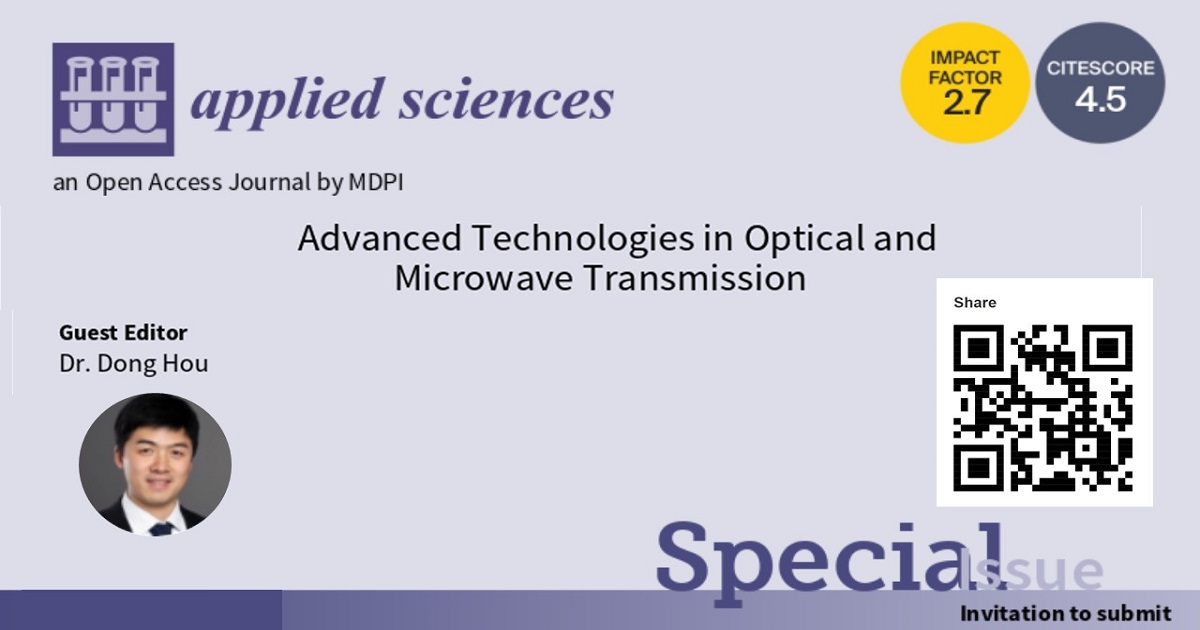Advanced Technologies in Optical and Microwave Transmission
A special issue of Applied Sciences (ISSN 2076-3417). This special issue belongs to the section "Electrical, Electronics and Communications Engineering".
Deadline for manuscript submissions: 30 August 2024 | Viewed by 3817

Special Issue Editor
Interests: optical and microwave transfer; optical and microwave measurement; time and frequency transfer; femtosecond laser
Special Issues, Collections and Topics in MDPI journals
Special Issue Information
Dear Colleagues,
Optical transmission is a technology that transmits optical signals between transmitters and receivers. Typically, its transmission links include optical fiber and free space, and it is widely used in optical fiber communication networks. Microwave transmission, on the other hand, employs wireless waves to transmit data signals and is commonly used as an access layer transmission technology in mobile communication networks.
The objective of both optical and microwave transmission technologies is to achieve signal transmission over long distance channels with high bandwidth, high stability, and low timing jitter. After decades of development, these transmission technologies have progressed rapidly and have achieved high-quality signal transmission. However, with the continuous advancement of basic scientific research and the evolving nature of application fields, traditional optical and microwave transmission methods and performance face significant challenges. Examples of such challenges include ultra-long-distance fiber and free-space communication, ultra-high-bandwidth communication, underwater optical and microwave transmission, and optical and microwave cross-application.
This Special Issue is dedicated to advanced technologies in optical and microwave transmission. The focus of the subjects to be discussed in this Special Issue will not only be on novel technologies and modern methods, but also on their implementation and verification for further applications.
Dr. Dong Hou
Guest Editor
Manuscript Submission Information
Manuscripts should be submitted online at www.mdpi.com by registering and logging in to this website. Once you are registered, click here to go to the submission form. Manuscripts can be submitted until the deadline. All submissions that pass pre-check are peer-reviewed. Accepted papers will be published continuously in the journal (as soon as accepted) and will be listed together on the special issue website. Research articles, review articles as well as short communications are invited. For planned papers, a title and short abstract (about 100 words) can be sent to the Editorial Office for announcement on this website.
Submitted manuscripts should not have been published previously, nor be under consideration for publication elsewhere (except conference proceedings papers). All manuscripts are thoroughly refereed through a single-blind peer-review process. A guide for authors and other relevant information for submission of manuscripts is available on the Instructions for Authors page. Applied Sciences is an international peer-reviewed open access semimonthly journal published by MDPI.
Please visit the Instructions for Authors page before submitting a manuscript. The Article Processing Charge (APC) for publication in this open access journal is 2400 CHF (Swiss Francs). Submitted papers should be well formatted and use good English. Authors may use MDPI's English editing service prior to publication or during author revisions.
Keywords
- optical fiber transmission/communication
- optical free-space transmission/communication
- optical communication network
- optical microwave transmission/communication
- radio over fiber transmission
- radio over space transmission
- underwater transmission/communication
- optical and microwave measurement in transmission
- optical and microwave detection in transmission





